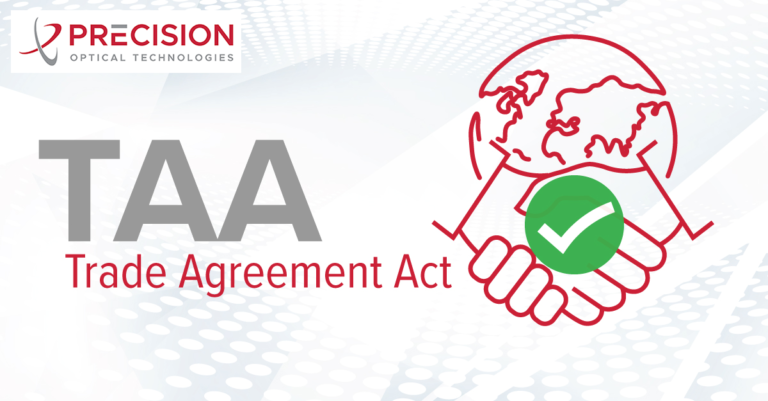
Precision OT & TAA Compliance: What it Means for Network Operators

What is The Trade Agreement Act (TAA) and why does it matters when choosing a vendor?
The acronym TAA refers to the Trade Agreements Act (19 U.S.C. & 2501-2581), which requires that the U.S. Government acquire only end products made in the U.S. or designated countries. Per the act, “contractors must certify that each end product meets the applicable requirements. End products are ‘those articles, materials and supplies to be acquired for public use’.” This includes items which have been “substantially transformed” in the United States. In this blog, we provide you with more information about TAA Compliance and what you can expect from us.
What’s required to be TAA Compliant?
TAA compliance is required for US federal procurements. This applies to federal acquisitions whose estimated value meets or exceeds listed thresholds (FAR 25.402). To be TAA-compliant, products must be substantially transformed in the United States of America or a TAA Compliant Country. TAA compliant countries are those specifically designated as such (FAR 25.003), WTO Government Procurement Agreement countries and those with a Free Trade Agreement (FTA) with the U.S. As defined by the Trade Agreement Act (TAA), compliance occurs when each product is substantially altered in the United States into a new or different article of commerce with “a name, character, or use distinct from that of the article or articles from which it was transformed”. The manufacturer must have both control over the source of their product as well as control over coding and proper full functional testing. Additionally, the manufacturer must be able to provide full Certificate of Origin information as well as data sheets for any of their products.
Although there is no official TAA certification, the responsibility of verifying TAA compliance rests solely on the contractor or supplier required to comply. TAA compliance is not an attestation standard. Rather, it is a certification of compliance ordered by the Customs and Border Protection (CBP). For many contractors and sub-contractors today, especially those that have an interest in pursuing contracts with the U.S. government or becoming part of any number of federal programs, partnering with TAA compliant vendors has never been more important. Let’s look at how you, as a current or potential customer, can rest assured that we at Precision OT are TAA compliant.
Examples of Substantial Transformation
In a world of economic specialization, many vendors, like us at Precision OT, bring in products like optical transceivers, which undergo substantial transformations here in the U.S. before being shipped to customers. According to the TAA, a product has been substantially transformed if its character, essence or use has been significantly altered by the vendor in question. However, many assembly operations will not satisfy these criteria. According to legal firm Steptoe, “an assembly operation involving relatively simple operations or…input parts (or subassemblies) already shaped and committed for use only in the finished product may not be sufficient to establish substantial transformation.” Here’s how the CBP views substantial transformation in the case of networking hardware.
When it comes to this kind of hardware, a high percentage of switches, routers and transceivers are manufactured outside of a TAA designated countries. Many manufacturing centers that specialize in networking and IT equipment (such as the Peoples Republic of China, Malaysia, and Thailand) are not currently included in the list of designated countries. The U.S. CBP, which issues advisory rulings and final determinations on Country of Origin (19 C.F.R. Part 177, Subpart B), has this to say: “CBP has examined the effect of downloading U.S.-developed software in previous decisions. For example, in HQ H258960, dated May 19, 2016, CBP considered the country of origin of network transceivers in two different scenarios. In Scenario One, the importer purchased ‘blank’ transceivers from Asia. The transceivers were then loaded with U.S.-developed software in the United States, which made the transceivers functional.” This scenario applies to what we do at Precision OT.
Precision OT and TAA Compliance
At Precision OT, we’re proud to be TAA compliant. Our customers for whom compliance is a contractual obligation can rest assured that partnering with us is the right move for their business.
As specialists in network systems integration, we code and customize the uncoded transceivers we receive to make them compatible both with our customers’ routers, switches and other requirements as well as optical equipment from other NEMs. The engineering we undertake delivers a significant transformation (user-friendly, high-quality transceivers that embody the spirit of plug-and-play) that is truly unique to us and delivers game-changing benefits to our customers. All of Precision OT’s optical transceivers are loaded with its proprietary EEPROM customized software. This product programing turns a non-functional part into a fully functional product. Precision OT’s cutting-edge programming and diagnostic technologies have been developed in the Unites States of America. All optical transceivers manufactured by Precision Optical Technologies, Inc are TAA compliant.






